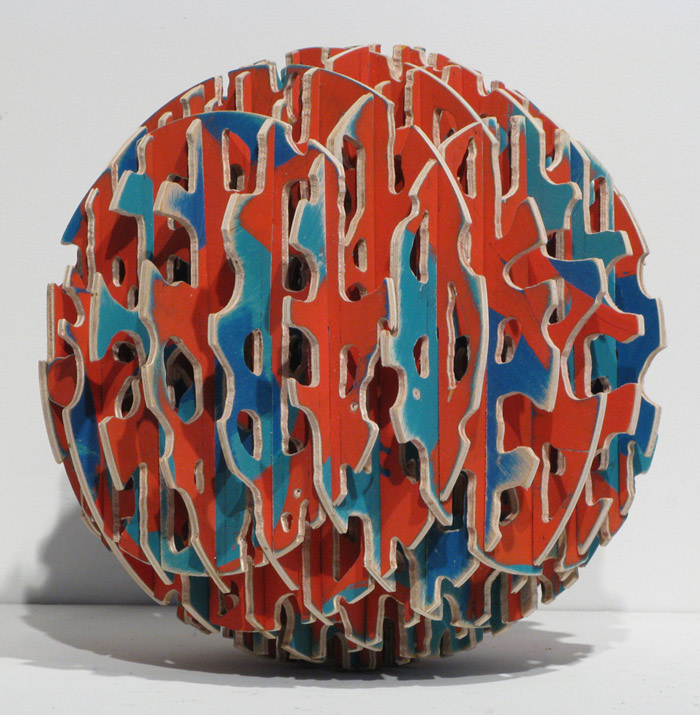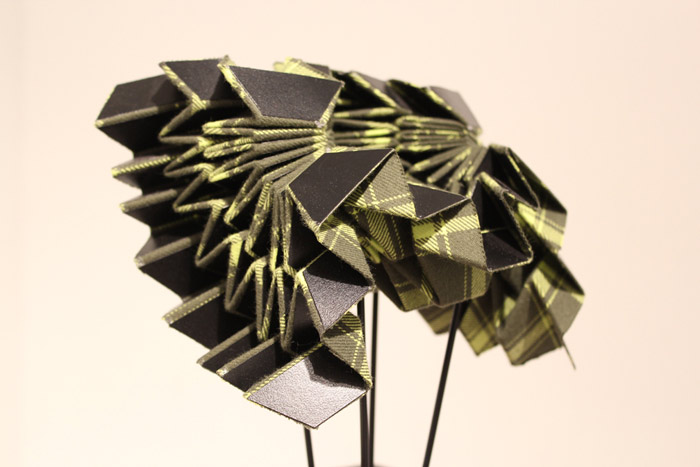Artist Sarah Bednarek’s work in sculpture and drawing addresses ideas of the finite and the infinite, of the perception and possibility of a mathematical and geometric ideal—one that eludes our grasp in our everyday reality but can be faintly glimpsed in mental images and in the world of the imaginary. She articulates a sense of this other world through an array of endlessly evolving permutations of lines, tessellated planar surfaces, and multi-dimensional volumes. They are realized graphically on paper or through the physicality of her deftly crafted constructions which operate as interventions of the hand into the world of the purely optical.
Some years ago the artist was confronted with the startling and unexpected news that she had Stage IV colon cancer. This was in 2009 when she was at the age of 29. She began to question her practice, what it comprised, and what it meant to make it at all. Then while undergoing treatment as well as grappling with reminders of her own finite nature and that of all things, she began to perceive new kinds of internal imagery. She sought to try to represent and understand what these illuminating but mysterious visions could mean.
From the artist’s own statements on her work:
“Hallucinating for hours while under the influence of both mortality and morphine, the experiences I had were regrettably mystical for a logical person, and conversely liberating…I imagined myself flying at high speed, head first into a crystalline world of ideal geometries, all pervaded with benevolent illumination—the quintessential ‘Go toward the light’ image we’re so familiar with. As moving as this was, I was left with some unsettling questions about my internal experience, and actual real space outside my mind. I could not help but analyze, for example, why my brain would invent this charming, but conventional vision. What is the difference between real and imagined space? Were these images implanted in my memory by Pop culture, or were they a true picture of death?”
There is something of beauty, terror, and unknowingness in the forms she creates. They seem to unfold with a grace and logic however woven with an obsessive detail that eludes easy comprehension. They retain a sense of their own troubled, questioning presences—and indeed each structure and drawing is like an unsettling, vexing proposition, a possible form or meaning of a form whose origins and intent are unknown to us. Do they beckon us with benevolence and illuminating wisdom, or is there a sense of threat, a danger that lurks inside as well? The structures do not reveal themselves to us, but they persist like mind-bending symmetries and asymmetries that confound our expectation.
They are like depictions of life and life-forms, unfolding and expanding in a multi-directional splendor before us. Their structures are organic yet geometric, suggesting both interiority and exteriority. They are models of structures that could populate some monumental futuristic urban planning design, or conversely also represent the microcosmic flux of cellular growth. Some works stand upon their own built-in pedestals like irregular creatures perched on giant stalks on an unknown shore. They may appear as disembodied, stand-alone wings without a body, or geometric vortices that draw you into the winding logic of their folds, a partial stab at the infinite, a glimpse of a spiraling DNA-like beyond. Bednarek employs careful gradations of color in her sculptures that compound the layers of enfolding in her more volumetrically-centered works, and elsewhere displays spiny shocks of an almost neon brightness in her lattice-works of thin, interwoven strands of wire bending through threaded space.
The warmth of the hues and the more organic and inviting textures of woven canvas on the surfaces of her sculptures seem to spurn the monumentality and coldness of the more hard-edged modernist design that her work nonetheless owes an acknowledged debt to. They can also make one think (at least for this one viewer) of the sprawling architectonic graphic scores of the avant-garde composer Iannis Xenakis and his pavilion for the 1958 Brussels World’s Fair (based on a design by Le Corbusier.)
But what of the nature of the architectural wonders and futuristic pavilions that Bednarek’s images and structures may conjure? They are themselves like a miniature, alternate world exposition mapping the unseen design of one mind’s imaginary—on one hand marked by a perhaps wildly fantastical futuristic thinking while also firmly couched in a sense of the ancient and distant past. The artist’s works are similarly free-floating possibilities of form may have once functioned as Ur-texts or keys to some possibility of the sacred—as links to the world of some forgotten god or gods housed in unusual dwellings of sand and stone that flicker in and out of our memory as from an unattainable dream.
By W. Ng

























